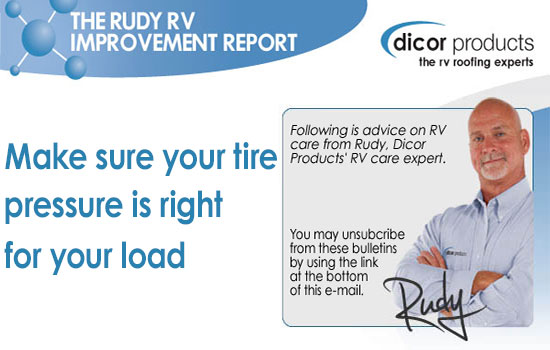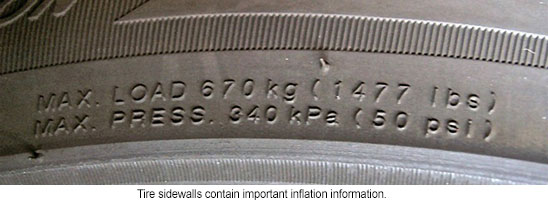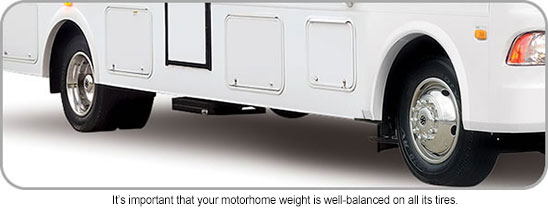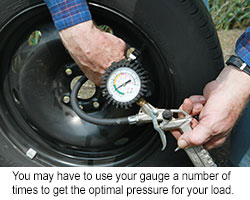

 |
|
In our last report we discussed how valve extenders can make checking tire pressure easier, especially with dual wheels. Now, with spring getting into gear, many RVers are starting to think about how they want to “load up” for another season on the road or at a favorite campground. This is where valve extenders become particularly handy, because as you start getting your “stuff” into the RV, you will need to make several pressure checks to make sure that your tire pressure is optimal for the amount of weight you’re carrying over each axle and each wheel. To set the correct tire pressure for your RV and what you’ll be carrying in it, first find on the sidewalls of your tires the maximum load rating and maximum inflation pressure for the tires. There are also similar ratings for the wheels that you should find stamped on them. If not, ask your dealer. On your RV there should also be a placard with the minimum tire pressure required. Never let your tire pressure go above or below these specified limits. Also, the proper time to check tire pressure is when the tires are cold, before the RV has been driven, or driven not more than a mile, as driving will naturally heat the air and boost the pressure, giving you inconsistent and faulty readings. 
To find the optimal tire pressure for your load you need to know how much your RV actually weighs and how that weight is placed, making sure it does not exceed the Gross Vehicle Weight Rating (GVWR), the Gross Axle Weight Rating (GAWR) and the gross wheel weight rating (half of the GAWR). All these ratings apply to a fully loaded RV, with all the people and stuff you will have in it, along with filled water, fuel and propane tanks and so on. For this kind of check you need to find a scale at a truck stop, RV center, farm supply place, or even gravel pit (look in the yellow pages) that will allow you to do several things: weigh the entire loaded vehicle, weigh just the front half of the vehicle for the front axle weight, just the back half of the vehicle for the rear axle weight, and to drive along the side of the scale so you can park one wheel on it at a time to get a weight for each wheel. 
Here is where many RVers run into a problem: they’ve overloaded their RV, or the RV is overloaded on one axle (most commonly the rear) but not the other axle. Or it could be overloaded over the wheel on one side but not the other. In such instances, RVers need to either remove or redistribute weight or do both if they are to avoid overstressing the tires (and other parts of the RV!) by exceeding the capacity they were designed for. Such overstressed tires can generate excessive heat and over time result in tire failure and potentially dangerous blow-out situations. If your weight is within the rating limits, you can find the optimal psi to use for the weight you have by consulting the tire manufacturer’s chart for your tire. But again, be mindful of the maximum and minimum pressures indicated.  Once you’ve done all this, however, one challenge remains: keeping your tires at the right pressure. If you add or subtract people and stuff from the RV, changing the load or load balance, the proper tire pressure will change as well. And, over time, tires will naturally loose pressure. As we noted in our last report, Bridgestone-Firestone estimates, depending on tire size, that a tire can lose 1 to 2 psi per month just by diffusion through the sidewalls. If there’s a bad valve stem or a faulty seal between tire and wheel, or the familiar nail in the tire, you lose even more pressure. So regular, continuing pressure checks are needed. However, Bridgestone-Firestone estimates that 40 percent of RVers only check their pressure once every six months, which means by that time the tire could be down as much as 12 psi without anything being wrong with it. Accordingly, it pays to check your tire pressure as often as you can. Tire manufacturers recommend pressure checks
By staying on top of your tire pressure in this way, you will not only ensure that your tires are not overstressed for the weight they’re supporting, but are also giving you maximum fuel efficiency and optimal ride and handling characteristics. In our next report, we’ll go over why this is so and the drawbacks and dangers of underinflated and overinflated tires. It pays to pay attention to your tires — they are literally the foundation of your RV experience! For more on RV care and maintenance go to: |
You are receiving this email because you have asked to receieve industry related product and service announcements from Dicor Products. If you would no longer like to receive these emails you may unsubscribe at any time using the link below. |